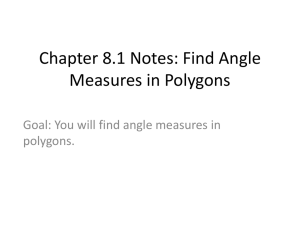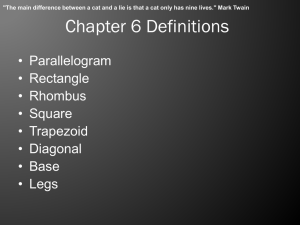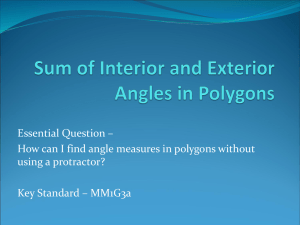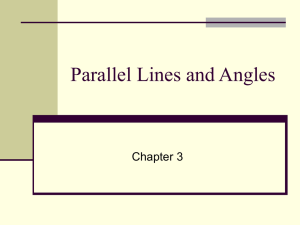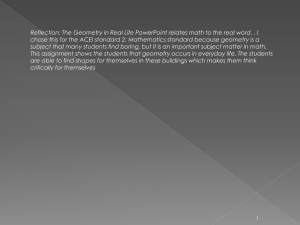Sum of interior angles in a polygon - KCPE-KCSE
advertisement
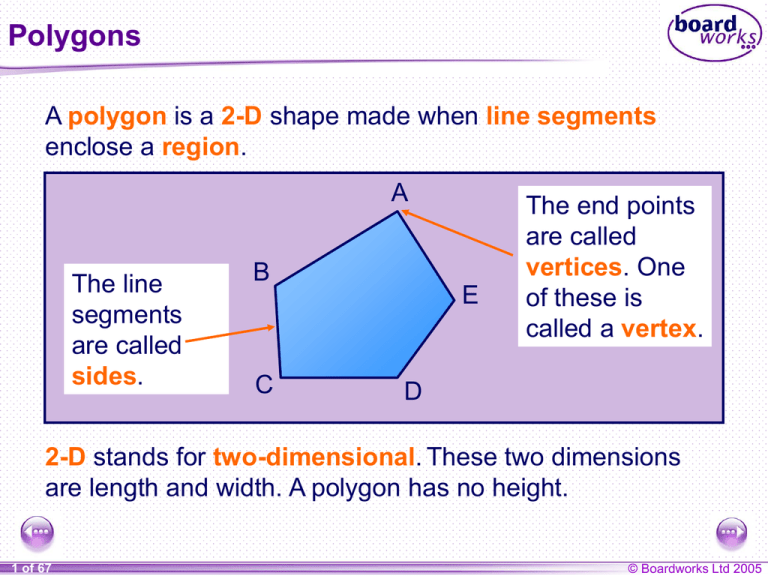
Polygons A polygon is a 2-D shape made when line segments enclose a region. A The line segments are called sides. B C E The end points are called vertices. One of these is called a vertex. D 2-D stands for two-dimensional. These two dimensions are length and width. A polygon has no height. 1 of 67 © Boardworks Ltd 2005 Polygons A regular polygon has equal sides and equal angles. In a convex polygon all of the interior angles are less than 180°. All regular polygons are convex. In a concave polygon some of the interior angles are more than 180°. 2 of 67 © Boardworks Ltd 2005 Naming polygons Polygons are named according to their number of sides. 3 of 67 Number of sides 3 4 5 Name of polygon Triangle 6 7 8 Hexagon Heptagon 9 Nonagon 10 Decagon Quadrilateral Pentagon Octagon © Boardworks Ltd 2005 Interior angles in polygons The angles inside a polygon are called interior angles. b c a The sum of the interior angles of a triangle is 180°. 4 of 67 © Boardworks Ltd 2005 Exterior angles in polygons When we extend the sides of a polygon outside the shape exterior angles are formed. e d f 5 of 67 © Boardworks Ltd 2005 Sum of the interior angles in a quadrilateral What is the sum of the interior angles in a quadrilateral? c d a f b e We can work this out by dividing the quadrilateral into two triangles. a + b + c = 180° So, and d + e + f = 180° (a + b + c) + (d + e + f ) = 360° The sum of the interior angles in a quadrilateral is 360°. 6 of 67 © Boardworks Ltd 2005 Sum of interior angles in a polygon We already know that the sum of the interior angles in any triangle is 180°. a + b + c = 180 ° a b d c c a b We have just shown that the sum of the interior angles in any quadrilateral is 360°. a + b + c + d = 360 ° Do you know the sum of the interior angles for any other polygons? 7 of 67 © Boardworks Ltd 2005 Sum of the interior angles in a polygon We’ve seen that a quadrilateral can be divided into two triangles … … a pentagon can be divided into three triangles … How triangles can … andmany a hexagon can bea hexagon befour divided into? divided into triangles. 8 of 67 © Boardworks Ltd 2005 Sum of the interior angles in a polygon The number of triangles that a polygon can be divided into is always two less than the number of sides. We can say that: A polygon with n sides can be divided into (n – 2) triangles. The sum of the interior angles in a triangle is 180°. So, The sum of the interior angles in an n-sided polygon is (n – 2) × 180°. 9 of 67 © Boardworks Ltd 2005 Interior angles in regular polygons A regular polygon has equal sides and equal angles. We can work out the size of the interior angles in a regular polygon as follows: Name of regular polygon Sum of the interior angles Equilateral triangle 180° Size of each interior angle 180° ÷ 3 = 60° Square 2 × 180° = 360° 360° ÷ 4 = 90° Regular pentagon 3 × 180° = 540° 540° ÷ 5 = 108° Regular hexagon 4 × 180° = 720° 720° ÷ 6 = 120° 10 of 67 © Boardworks Ltd 2005 The sum of exterior angles in a polygon For any polygon, the sum of the interior and exterior angles at each vertex is 180°. For n vertices, the sum of n interior and n exterior angles is n × 180° or 180n°. The sum of the interior angles is (n – 2) × 180°. We can write this algebraically as 180(n – 2)° = 180n° – 360°. 11 of 67 © Boardworks Ltd 2005 The sum of exterior angles in a polygon If the sum of both the interior and the exterior angles is 180n° and the sum of the interior angles is 180n° – 360°, the sum of the exterior angles is the difference between these two. The sum of the exterior angles = 180n° – (180n° – 360°) = 180n° – 180n° + 360° = 360° The sum of the exterior angles in a polygon is 360°. 12 of 67 © Boardworks Ltd 2005 Find the number of sides 13 of 67 © Boardworks Ltd 2005
